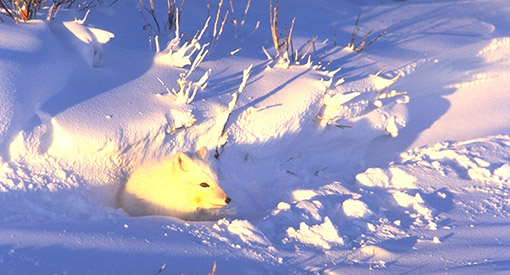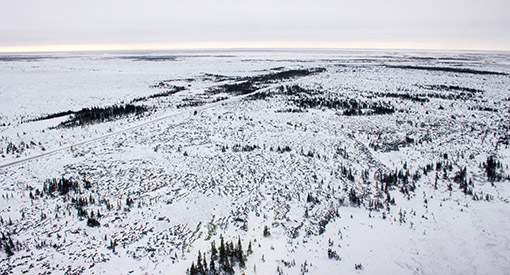Nancy Spence
Wapusk National Park
As a lifelong Churchill resident, Nancy Spence remembers what Wapusk National Park was like before it was officially protected as a park. Nancy now visits the land as an Indigenous Relations Officer for Parks Canada. However, she holds dear memories of spending time on the land as a teenager, trapping with her brother, Donald.
During the season from late November to about Christmastime, Donald would check his traps regularly — every other day, at least — for martens, foxes and the occasional mink.

“The reason for the short season is because our family was taught to respect the land and only take what you need. A lot of trappers these days think the higher number of furs you get, the better trapper you are, but that’s not the case,” Nancy explained. “My family was taught not to over-harvest — if you do, there’s not always going to be a healthy balance for future generations.”
Nancy would sometimes join him on weekends. Admittedly, she didn’t necessarily enjoy the experience initially, but came to appreciate it in time.
“I recall getting up early Saturday and Sunday mornings, putting on all the winter gear, going outside. It was always cold and wondering why anyone would want to do this kind of stuff, then it would kick in that this was part of my heritage and I had it easy,” Nancy said.
Nancy’s expeditions with Donald were less strenuous than for others in her family in that they were day trips by snowmobile, whereas in the past, her father and uncle had to travel by dog team for multiday journeys to check their traps. Donald’s traps were set in the areas near Norton Lake, Mast River, the eastern creeks and south of the Nestor 2 research station.
“My brother would trap marten and foxes; I’d be happy if that’s all he would get, but sometimes he would trap a mink and I would dread the day when that animal had to be skinned because they don’t smell very nice,” Nancy said.
Around the time Wapusk was being incorporated, Nancy, 15 at the time, recalls Prince Charles journeying to Churchill to witness the Government of Canada and Province of Manitoba signing the accord to officially create the park. In particular, she remembers shaking his hand, as well as his helicopter landing in the local baseball field and the huge security presence that came with him.
Knowing that protecting polar bears was a driving factor to create the park meant many locals welcomed the decision, she remembered.

These days, Nancy is involved with a number of ongoing projects centred on proactively strengthening the connection between Indigenous communities and Parks Canada administered sites, including Wapusk National Park. She recently accompanied Manitoba Métis Federation representatives into the park to install trail cameras in the fall of 2021.
“They’re always willing to share. It’s great working with these communities because a lot of times, they give a lot more than what you’re asking,” Nancy said. “You learn a lot. A lot of people don’t realize that if you’re interviewing a certain person and they’re quiet, it doesn’t mean that the interview is over. You have to be comfortable in silence because sometimes, they’re just reflecting and getting things together, so you just have to be comfortable.”
Nancy has visited various parts of Wapusk over the years, most often travelling by helicopter but taking a snowmobile on occasion (though given the cost of fuel and the distance, it’s not a popular option).
Upon spotting cultural resources such as tent rings when she’s visited Wapusk, Nancy imagines what it was like to be on the same lands centuries ago.
"You just start thinking how the park was 300 or 400 years ago, or even before that,” Nancy said.
Nancy first started working with Parks Canada in 2005 and has worked in a variety of roles with the agency in the intervening years. One of her earliest experiences with Parks Canada involved accompanying a group of University of Manitoba students to the Nester 1 research station.
Realizing that a large part of her job is spent in a place that’s a once-in-a-lifetime destination for the vast majority of its visitors filled her with gratitude.
“That was an eye-opener,” Nancy said. “Once you see everything every single day, it gets kind of repetitive, but spending that time with that group on the land and realizing that this is the only time they’re probably going to see this, you appreciate it more. It was life-changing. I appreciate going out there a bit more and spending time out there because I know a lot of people don’t get that opportunity.
“A lot of my friends say, ‘Take me with you!’” Nancy added. “They’re pretty envious of the things I get to do.”
- Date modified :